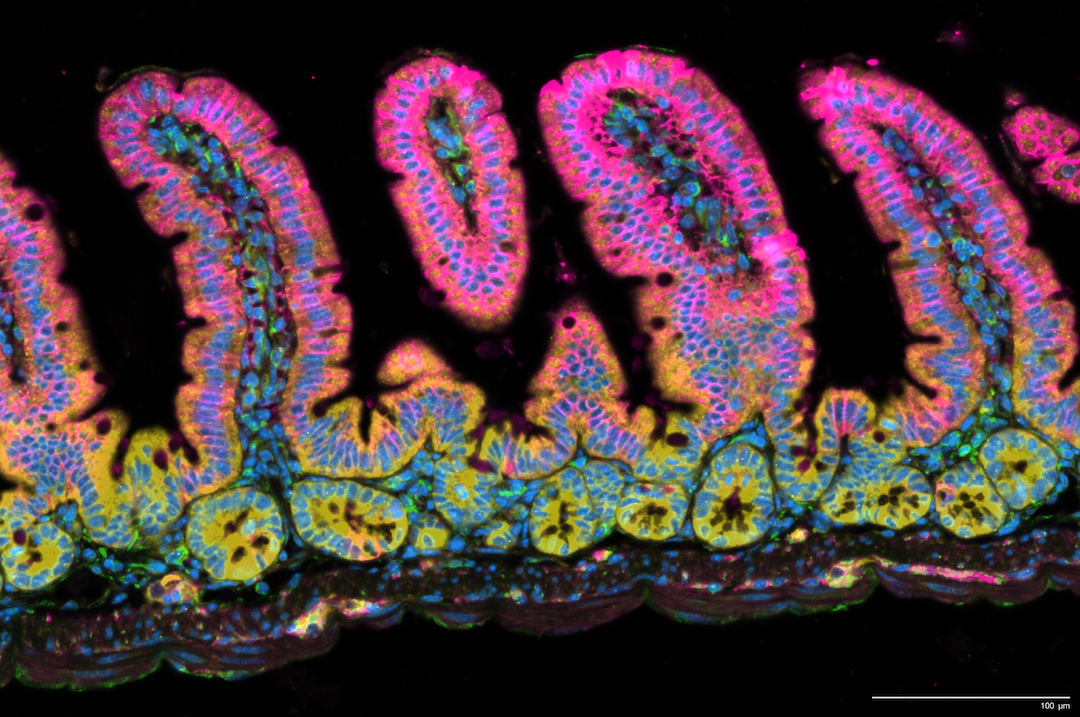Two seemingly incompatible tasks must be balanced by the cells lining your small intestine: taking in nutrients from food and watching out for pathogens that might try to enter your body.
This is a surface where pathogens can sneak in,
That’s a massive challenge for the immune system.
Miguel Reina-Campos
How, then, do immune cells protect the gut? Tissue-resident memory CD8 T cells (TRM cells) are pathogen-fighting immune cells that undergo an unexpected transformation—and relocation—as they combat infections in the small intestine, according to new research led by researchers from LJI, UC San Diego, and the Allen Institute for Immunology.
To combat infections before they have a chance to spread to deeper, more susceptible locations, these cells actually ascend higher in the tissue.
The tissue in the gut has evolved to provide signals to immune cell infiltrates—to put immune cells in specific places so they have a better ability to stop pathogens.
Reina-Campos
Their findings were published in the journal Nature.
The latest research supports the increasing amount of data showing immune cells can change their structure to defend particular areas. According to Reina-Campos, these “tissue-resident” immune cells could play a significant role in upcoming cancer immunotherapies that target organ-specific malignancies.
The development of TRM cells in the small intestine was examined by Reina-Campos and associates. The group tracked these cells in tissue samples from mice and humans using a state-of-the-art technique known as spatial transcriptomic.
Their research revealed that two different kinds of TRM cells are found in the small intestine. These cells are divided between the “crypts” that lie between the projecting villi or the tiny, finger-like “villi” that line the small intestine.
Progenitor-like TRM cells, the researchers discovered, reside nearer the crypts between the villi. However, toward the top of the villi, distinct TRM inhabit more exposed areas.
Because they are more visible at the top of the villi, differentiated immune cells are better able to defend you against infections there.
Differentiated immune cells are more exposed at the top of the villi, and that’s where they have a better ability to protect you from infections.
Reina-Campos
A reserve population of TRM cells that resemble progenitors is still present in the crypts at low levels.
These cells can replenish the pool of effector T cells, so the immune system keeps them as back-ups in the deeper parts of the tissue.
Reina-Campos
What controls and organizes these populations?
Reina-Campos and associates employed a novel technique known as spatial transcriptomics to concurrently monitor millions of messenger RNA molecules at subcellular resolution in order to spy on these significant immune cells in their natural environment.
For the first time, we were able to capture the formation of immunological memory in space and time.
Reina-Campos
After studying small intestines following a viral infection, the researchers discovered that the stomach sends out chemical cues to tell immune cells what to do and where to go.
This study offers a new resource for finding signals that position immune residents to strengthen our gut immunity.
Reina-Campos
Also Read: Researchers discovered that male and female microglia function differently
Reina-Campos attributes the success of this study to the knowledge of Heeg and Monell, as well as his mentor, Goldrath. Heeg and Monell created novel computational techniques to interpret the vast volumes of data obtained through spatial transcriptomics, as Reina-Campos describes.
It’s led to a breakthrough in our ability to look at hundreds to thousands of genes simultaneously in intact tissues,
With this study, we’ve opened up a new path for discovery,
To be a chess grandmaster, you need to know not only about the pieces: the bishops, pawns, rooks, etc, but also how they move in concert on the chessboard.
Reina-Campos
Source: La Jolla Institute for Immunology – News
Journal Reference: Monell, Alexander, et al. “Tissue-resident Memory CD8 T Cell Diversity Is Spatiotemporally Imprinted.” Nature, 2025, pp. 1-10, DOI: https://doi.org/10.1038/s41586-024-08466-x.
Last Modified:




